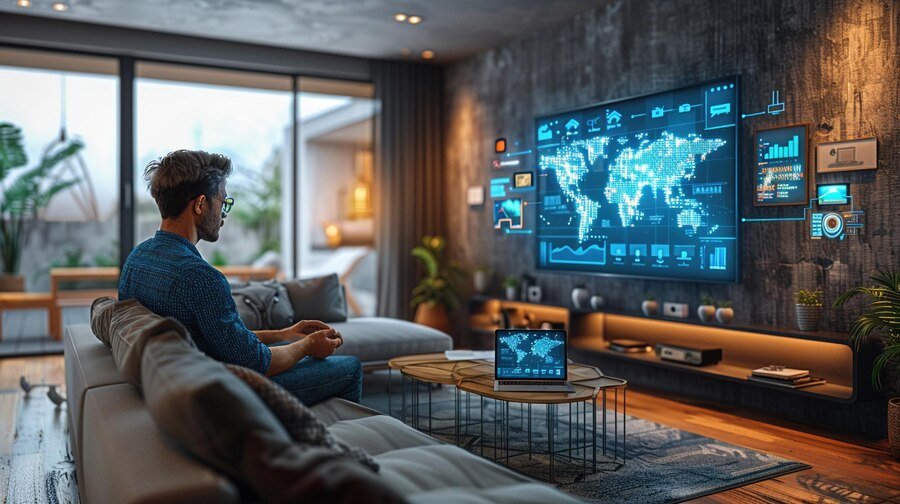
Introduction to User Interface (UI)
In today’s digital landscape, the user interface (UI) is more than just a collection of buttons and menus. It serves as the vital link between users and technology, shaping our interactions with devices, apps, and websites. As we navigate through countless applications each day, from social media platforms to online banking systems, it becomes clear how crucial a well-designed UI is for enhancing usability and overall experience.
Imagine trying to book a flight on an airline website that looks cluttered or feels confusing. Frustrating right? That’s exactly where good UI design comes into play. A seamless user interface not only makes tasks easier but also fosters engagement and satisfaction. In this article, we’ll explore the multifaceted world of user interfaces—unpacking their importance in technology while highlighting what makes them successful or unsuccessful in bridging users with the tools they need.
Let’s dive deeper into the intricacies of user interfaces—what sets them apart and why they matter so much in our tech-driven lives!
The Importance of UI in Technology
User interface (UI) plays a crucial role in technology. It acts as the bridge between users and digital systems, enabling seamless interaction with devices and applications. A well-designed UI can significantly enhance user satisfaction.
When users engage with technology, their experience is heavily influenced by the UI design. A cluttered or confusing interface can lead to frustration, while an intuitive one fosters efficiency and enjoyment. This balance is essential for keeping users engaged over time.
Moreover, a good UI extends beyond aesthetics; it enhances functionality too. Users should not only find what they need quickly but also enjoy doing so without unnecessary hurdles.
In today’s tech-driven world, businesses recognize that investing in quality user interfaces is vital for success. Effective UI design transforms complex processes into simple actions that anyone can understand and use effortlessly.
The Evolution of User Interface
The evolution of user interface has been a remarkable journey. From the early days of command-line interfaces, where users typed in complex commands, technology has transformed dramatically.
As graphical user interfaces (GUIs) emerged, they revolutionized how people interacted with machines. Icons and windows made navigation intuitive for all kinds of users.
With the rise of touchscreens, our engagement with devices became even more natural. Swiping and tapping opened new avenues for interaction that are now second nature.
Voice-activated interfaces have further pushed boundaries. Virtual assistants allow us to communicate without lifting a finger or staring at a screen.
Now we’re witnessing the advent of immersive technologies like augmented reality (AR) and virtual reality (VR). These platforms promise an entirely different level of user experience that blends digital elements seamlessly into our physical world.
Each stage reflects not just technological advancements but also evolving human preferences and behaviors in interacting with devices.
Key Elements of a Good UI
A good user interface (UI) is built on several key elements that enhance usability. First, clarity is crucial. Users should instantly understand how to navigate and interact with the system.
Consistency plays a vital role as well. Similar elements must behave in predictable ways across the platform, reducing cognitive load for users.
Visual hierarchy guides attention effectively. By emphasizing important features through size or color, designers can lead users through tasks intuitively.
Feedback mechanisms are another essential aspect. Instant responses to user actions help them feel more in control and informed about their interactions.
Accessibility cannot be overlooked. A UI must cater to everyone, including individuals with disabilities, ensuring that technology is inclusive and functional for all users. These foundational components work together harmoniously to create an engaging experience that fosters satisfaction and loyalty among users.
Different Types of User Interfaces
User interfaces come in various forms, each tailored to specific user needs and contexts. Graphical User Interfaces (GUIs) dominate the landscape, allowing users to interact with visual elements like buttons and icons. This format is popular due to its intuitive nature.
On the other hand, Command Line Interfaces (CLIs) offer a more technical experience. They require users to type commands directly but grant greater control for those familiar with programming.
Touch User Interfaces have gained traction with smartphones and tablets. Users can swipe, tap, or pinch their way through applications, making interactions fluid and dynamic.
Voice User Interfaces are emerging as another innovative option. With voice recognition technology advancing rapidly, speaking commands offers an effortless hands-free experience.
Natural Language User Interfaces let users communicate in everyday language. These systems interpret requests naturally—making technology even more accessible for everyone involved.
Challenges in Creating an Effective UI
Creating an effective user interface (UI) is fraught with challenges. One major hurdle is understanding the diverse needs of users. Each person interacts differently with technology, and catering to every preference can be daunting.
Another challenge lies in balancing aesthetics and functionality. A visually stunning design might not always serve its purpose if it complicates navigation or accessibility. Striking this balance requires careful consideration and testing.
Additionally, keeping up with rapidly changing technology poses a significant obstacle. New devices, platforms, and trends emerge constantly, demanding that UI designers stay adaptable and informed.
User feedback also plays a crucial role but can often be contradictory. What one group finds intuitive may frustrate another. This variability makes it essential for designers to iterate continuously based on real-world interactions rather than assumptions alone.
Resource constraints—be it time or budget—can limit the depth of research needed to create a truly effective UI experience.
Types of User Interfaces
User interfaces come in several forms, each tailored to specific user needs and technology types. Graphical User Interfaces (GUIs) are the most common, utilizing visual elements like buttons and icons for interaction. They provide an intuitive way for users to engage with software.
Command Line Interfaces (CLIs), on the other hand, rely solely on text input. While they may seem daunting at first, many power users prefer them for their efficiency and speed.
Touch interfaces have gained popularity with the rise of smartphones and tablets. They allow direct interaction through taps and swipes, creating a seamless experience.
Voice User Interfaces (VUIs) are becoming increasingly prevalent as smart assistants enter our daily lives. Users can now interact using voice commands, making hands-free operation a reality.
There are Natural Language User Interfaces that enable communication in everyday language. This type fosters accessibility by allowing more people to navigate complex tasks without technical jargon.
Benefits of a Good User Interface
A good user interface is essential for enhancing user satisfaction. When users can navigate seamlessly, they are more likely to engage with the product.
Efficiency is another key benefit. A well-designed UI minimizes confusion, allowing users to complete tasks quickly and accurately. This efficiency translates into time savings.
Then there’s accessibility. An intuitive UI accommodates various skill levels and backgrounds, making technology approachable for everyone.
Moreover, a polished user interface builds trust and credibility. Users feel comfortable when they interact with clean layouts and responsive elements.
An effective UI can lead to increased conversion rates for businesses. Customers are more inclined to make purchases when their experience feels smooth and enjoyable.
Investing in a good user interface pays off through enhanced loyalty and positive word-of-mouth referrals.
Factors to Consider for Designing an Effective User Interface
When designing an effective user interface, clarity is paramount. Users should navigate effortlessly without confusion. A clean layout with intuitive icons helps achieve this goal.
Responsiveness is another critical factor. Interfaces must adapt seamlessly to various devices and screen sizes. This ensures a consistent experience whether on mobile or desktop.
User feedback plays a vital role as well. Observing how real users interact with the design can unveil hidden pain points that need addressing.
Accessibility cannot be overlooked either. An inclusive design accommodates individuals with diverse abilities, expanding your audience reach significantly.
Aesthetic appeal matters too. A visually pleasing interface draws users in and keeps them engaged longer, enhancing overall satisfaction and retention rates across platforms.
Tips for Improving User Experience
Improving user experience is essential for any successful application or website. Start by prioritizing simplicity in design. Users appreciate clean layouts that are easy to navigate.
Next, ensure your content is concise and relevant. Avoid overwhelming users with excessive information. Clear calls-to-action guide them effectively through tasks.
Consider accessibility as well. Design interfaces that cater to all users, including those with disabilities. This creates an inclusive environment where everyone can thrive.
Regularly gather feedback from real users to identify pain points in their journey. Listening directly helps you understand what needs improvement.
Additionally, focus on responsiveness across devices. A seamless experience on desktops, tablets, and smartphones builds trust and satisfaction among your audience.
Keep performance optimization at the forefront of your strategy; fast-loading pages enhance overall engagement significantly.
Future Trends in User Interface Design
The future of user interface is poised for exciting innovations. As technology evolves, interfaces will become more intuitive and adaptive.
Artificial intelligence plays a significant role in this transformation. Expect personalized experiences that learn from user behavior, making interactions seamless and efficient.
Voice and gesture controls are gaining traction too. These methods allow users to interact naturally with devices, reducing reliance on traditional inputs like keyboards or touchscreens.
Augmented reality (AR) is another trend to watch. It enhances the real world by overlaying digital elements, creating immersive experiences that change how we perceive information.
Accessibility features will become central in UI design. Designers will prioritize inclusivity by ensuring all users can navigate effortlessly through interfaces tailored for diverse needs.
These trends hint at a future where user interfaces are not just functional but also engaging and accessible for everyone.
Conclusion
User interfaces play a crucial role in connecting users with technology. As we navigate through an increasingly digital world, the importance of effective UI design cannot be overstated. A well-designed user interface enhances user experience and drives engagement, making it essential for businesses and developers alike.
The evolution of user interfaces has been remarkable, moving from command-line inputs to rich graphical designs that prioritize usability. Understanding key elements such as layout, color schemes, typography, and feedback mechanisms is vital for creating engaging experiences.
Different types of user interfaces serve various purposes—from simple touch screens to sophisticated voice-activated systems. Yet challenges remain in crafting intuitive designs that cater to diverse audiences while remaining functional.
A good user interface brings many benefits: improved customer satisfaction, increased productivity, and reduced frustration among users. Designers must consider factors like accessibility standards and responsive design when developing their UIs.
As trends shift towards personalization and immersive technologies like augmented reality (AR) or virtual reality (VR), staying informed about upcoming advancements will be critical for future success in UI design.
The journey toward mastering the art of user interface continues to evolve alongside technological innovations. Embracing best practices now will undoubtedly shape how users interact with devices tomorrow.
RELATED POSTS
View all


